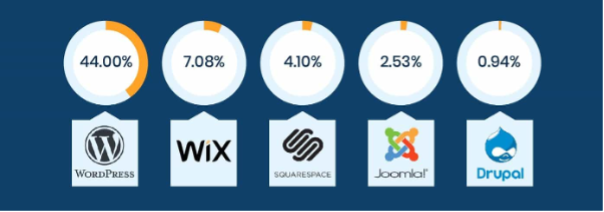After you did your planning and domain registration, it's time to develop!

The 5 steps to building a website
The following stages are followed by most website projects:
- Make a plan for the structure and content of your website.
- Register a domain name, preferably a.com.
- Develop your website.
- Make it search engine friendly.
- Start your website.
3. Develop your website
Let's look at the most common methods for starting a website. There are several options. Some are more adaptable than others, while others are more difficult.
Using a website builder to create a website
Let's begin with the most straightforward option: a website builder. This is a "all-inclusive" bundle in the sense that it is generally provided by a single firm, which includes the template (design), drag-and-drop editor, web hosting, domain name, email address, and support. The hardest duties are handled by the web builder.
This is beneficial for more than just novices. Simply put, it is dependent on the job. Why complicate your life when there are simple solutions? Almost all site builders allow you to establish a free, ad-supported basic website on a subdomain (for example, yourname.sitebuildername.com). You may test it thoroughly before deciding whether the purchase is justified.
If you wish to take your company online, though, you need select a premium service. Prices start at roughly €6 per month and include everything you need. If you require a professional email address for your company website, add roughly €1-5/month.
Pros:
-
It's simple to use.
-
No additional software or even hosting is required.
-
You don't need any technical skills to get started.
-
The website construction business is in charge of updates and security.
-
Themes that you may customize to your liking.
-
By default, a mobile-optimized version is supplied.
Cons:
-
It's not always possible to add more functionality (depending on the website builder).
-
Because you're reliant on the supplier, it's less flexible.
-
They aren't intended for more complex database-driven tasks (e.g. a job board or real-estate directories)
Website builder comparison tool: https://www.tooltester.com/en/wix-vs-squarespace-vs-godaddy-vs-weebly-vs-wordpress-com/
Using a content management system to build a website
CMS (content management systems) are a little trickier. They are significantly more difficult to use than a website builder, despite the fact that they function in the same way.
You may not only upload simple stuff like texts and photos to a website builder, but you can also construct a whole website with it. In this scenario, a traditional content management system would be far more restrictive, and you're confined to the templates provided in terms of look.
While there are several systems such as Joomla!, Drupal, and Typo3, we'll concentrate on WordPress, the most popular CMS. It's not difficult to set up thanks to hosting firms that offer one-click installations.
Data credit: BuiltWith
As you can see, WordPress powers roughly half of all websites on the Internet.
Alternatives to WordPress:
-
Wix is a basic drag-and-drop website builder that is easy to use, but it is more expensive, not ideal for larger projects, and it is hard to transfer your website out if the need arises.
-
Squarespace is an aesthetically pleasing website builder that makes constructing stunning websites simple, but it comes at a higher monthly fee and lacks a migration feature.
-
Drupal is a robust platform that is popular among experienced web developers and coders, but it has a steep learning curve that makes it unsuitable for novices.
-
Joomla is similar to WordPress and is a useful tool for creating websites, but it does need at least a basic grasp of how to use it.
You may also quickly install a WordPress theme and customize it using the design options. However, if you don't like anything, you'll most likely have to change the CSS or HTML (you or a programmer).
Your choice of hosting, domain, email address, installation, and degree of support will be determined by your budget and technical competence. If you do it yourself, it may be pretty inexpensive.
The dozens of plugins available, particularly for WordPress, allow you to add extra functionality to your website that were not originally included. WooCommerce, a plugin that offers a comprehensive online store, is a good example.
Pros:
-
You have a choice of hosting companies.
-
Excellent for multilingual websites.
-
Technical flexibility: if you know what you're doing, you can access the entire source code.
-
Plugins provide additional functionality.
-
You can make your page load faster.
Cons:
-
There is no direct personal technical assistance (only limited support from your web host)
-
The template determines the level of creative flexibility.
-
The plugins may incur additional fees.
-
Even minor aesthetic adjustments may necessitate the use of a programmer.
How to create a website yourself or with an agency
Those who require complete freedom must create the page themselves. You'll need patience for this, and it's frequently intimidating for newcomers (and frustrating).
Websites like Codecademy, Mozilla, and W2Schools, which feature step-by-step instructions for novices, are a fantastic place to start. However, be prepared for a long trip until your website is complete. You may, of course, engage a web designer to expedite the process. Just remember that your designer should not be performing your coding and vice versa. Each of these duties necessitates a unique set of talents.
It's difficult to give a general pricing because it depends on the job. You'll obviously have to pay for hosting, but there are many of low-cost options available. Above all, hiring a programmer will be far more expensive: paying $8-15 per month for a website builder will always be less expensive than hiring a designer or agency for an hour of labor.
NetBeans, Aptana Studio, and Brackets are other prominent programming tools. All of them are free and support HTML, CSS, JavaScript, and PHP. Webflow, a visual source code editor, is another choice.
Pros:
-
If you know how to program, the possibilities are endless.
-
Cost-effective hosting.
-
Maximum adaptability
Cons:
-
There is no (or expensive) assistance.
-
It's a high learning curve.
-
The expenses are difficult to estimate.
-
It takes a long time to study and apply.
























